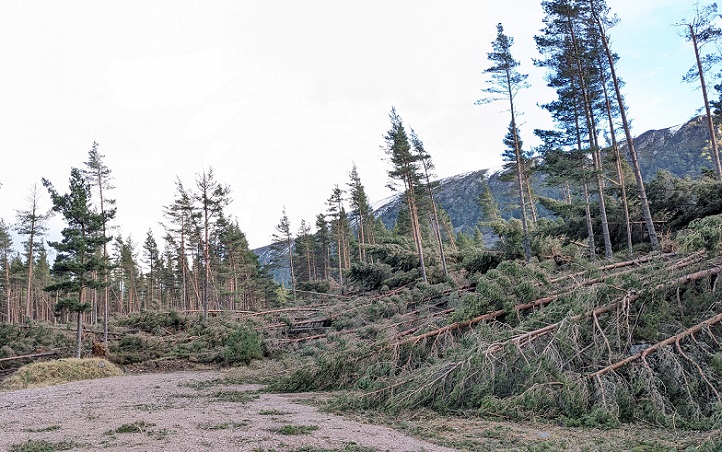
While staying in Newtonmore over New Year I heard that Storm Gerrit, which had hit Scotland on Boxing Day, had caused some spectacular damage in the lower parts of Glen Feshie. On my last day I went to have a look, little expecting that I would also get a post on sheep and woodland out of my visit (see here)!
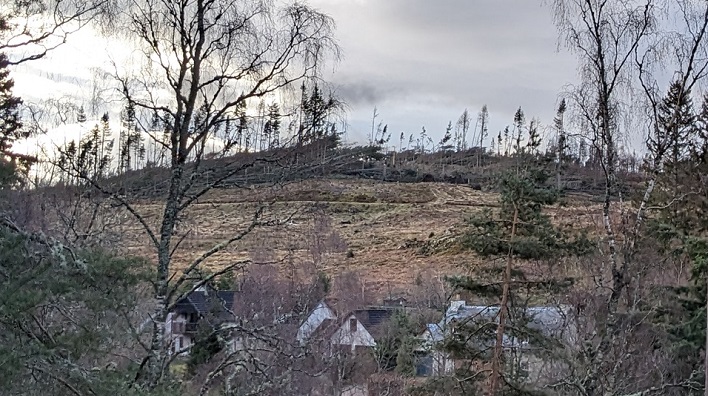
While it was difficult to get an overall sense of of the impact of the storm from the floor of the glen, it was apparent that quite large areas had been devastated.
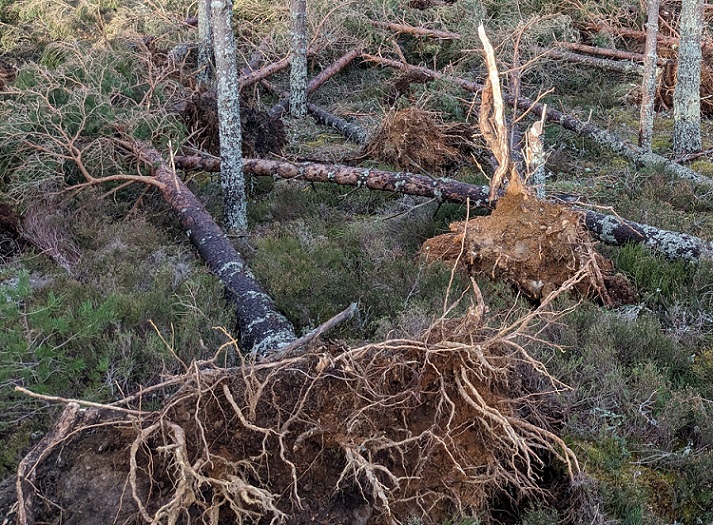
The force of the wind in places appears to have been immense. Usually when conifers blow over they are uprooted, with shallow roots lifting the soil with them, i.e it is the soil that gives way. Not so here. There were other trees whose roots had held but which had snapped half-way up their trunks.
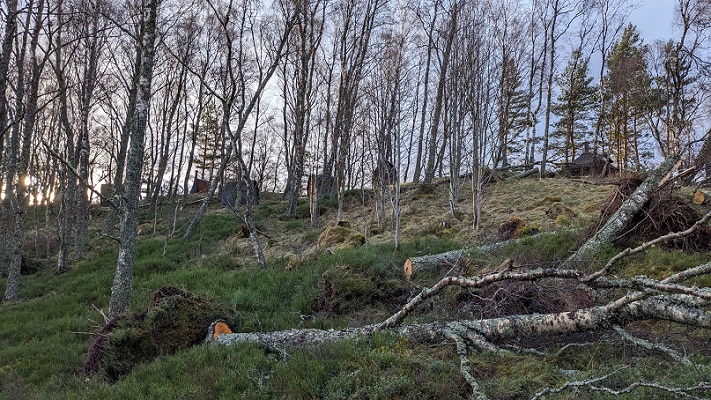
The straggly birch trees at Lagganlia Outdoor Centre had survived somewhat better, with the younger trees more able to bend with the wind, but it must have been a scary experience for anyone staying in the pods or living in these woods.
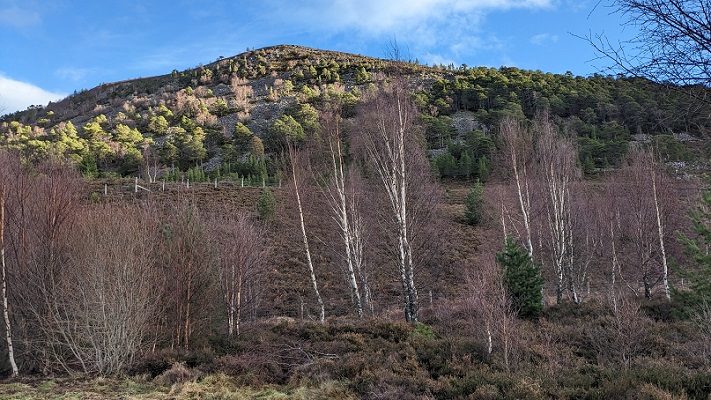
Further up the glen, at the end of the public road, looking up the hill to the ancient Caledonian Pine Forest there was very little evidence there had been a storm. All the old Scots Pine on the bouldery slopes on the slopes appeared to be still standing despite, or perhaps because of, the lack of soil.
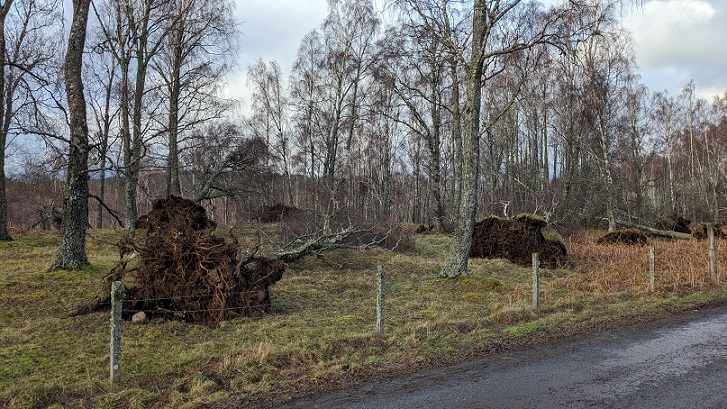
Wind behaves in complex ways as it blows across the landscape and its force and direction appear to have varied over quite short distances along Glen Feshie. The birch in this photo, for example, appear to have had been toppled in a northerly direction while some of the Scots Pine lower down the glen appear to have fallen in a more westerly direction.
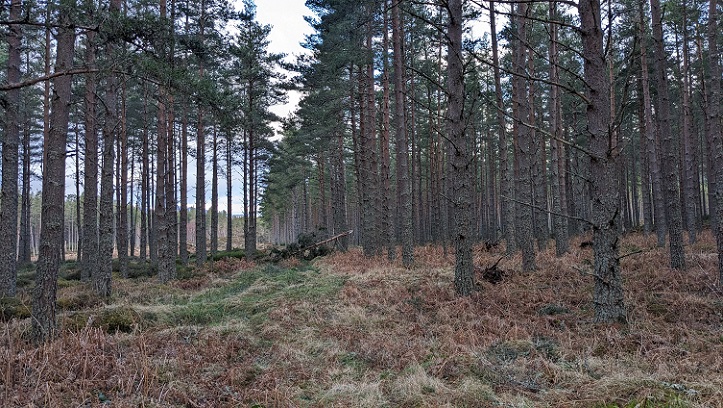
Unless you factor in how the wind varied across the landscape, it is difficult to fully explain how some areas of Scots Pine plantation have survived better than others, though past thinning of the area in the photo above may had enabled the trees to develop bigger and stronger roots.
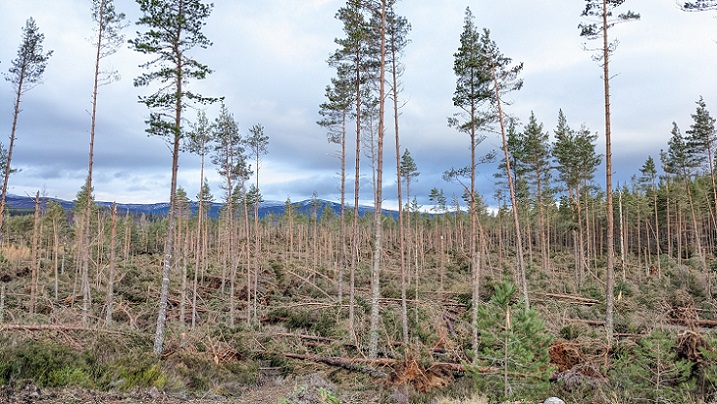
Set the wind aside, however, and Storm Gerrit appears to have made a much greater impact on plantations in Glen Feshie than other types of woodland.
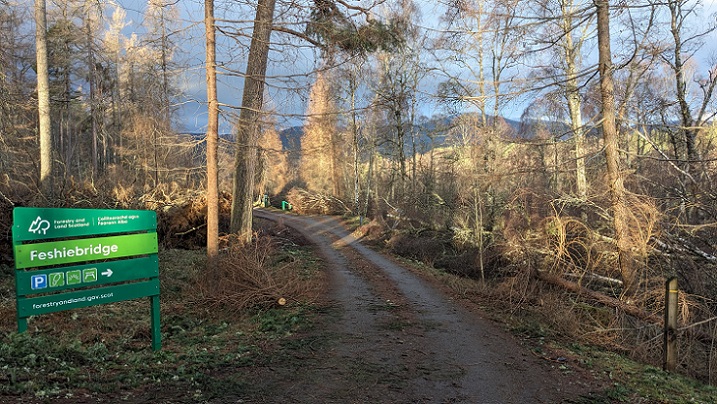
This should not be a surprise. Forest Research using satellite data showed that Storm Arwen had affected at least 5,700 hectares of coniferous forest and small woodlands across Scotland and Northern England. That was almost half of Scottish Forestry’s annual planting target of 12,000 hectares, designed in part to offset carbon and help mitigate climate change.
In purely carbon terms, if one discounts other factors, the amount of CO2 released into the atmosphere by windthrown trees far outweighs that absorbed by newly planted trees. If we are serious about mitigating climate change, therefore, it is very important that the wood from windthrown timber is, like that from mature plantations, used and embedded as far as possible in human products. (While there is an important place for dead wood in nature we don’t need whole plantations of the stuff).
The impact of Storm Gerrit in Glen Feshie will have created a major headache for Forest and Land Scotland (FLS). Windthrown Scots pine degrades more rapidly than spruce due to its susceptibility to
attack by bark beetles and sap stain fungi (blue stain). This destroys its market value and industry advice is the trees need to be removed in six months. With FLS no longer employing local foresters and without a local market – the small sawmills that you find in almost every Alpine village – the impact of events like Storm Gerrit pose a particular challenge.
Plantation forestry is no longer sustainable with climate change

Scottish Forestry’s public data base includes mapping to show the climatic suitability of land across Scotland for different types of trees. It classifies land as “Very Suitable”, “Suitable”, “Marginal” and “Unsuitable”, crude no doubt but an expression of the official position. Both the research evidence (see here) and that of the regenerating Caledonian Forest suggest that the lower parts of Glen Feshie should still be “Very Suitable” for Scots Pine but what Storm Gerrit shows is that is only if NOT grown in plantations. The Scottish Government and its agencies, FLS and Scottish Forestry therefore need to review their whole approach to tree planting and climate change.
The current presumption by Scottish Forestry is that windthrown plantations should be re-stocked, i.e.re-planted. It is partly for this reason that they require felling licenses before most windthrown trees can be removed (there is an exception that covers trees which have blocked roads, pose serious safety risks etc). While FLS has a felling license for its land at Invereshie, this was enable the plantation to be thinned and to make it more like the surrounding Caledonian Pine Forest. All those plans have now been overtaken by Storm Gerrit. It is now critically important that after removing most of the windthrown timber FLS does not re-plant and leaves the area to regenerate naturally. What’s more they should apply this lesson to all their extensive landholdings on Speyside.

There are some serious questions to be asked about Scottish Forestry’s climatic suitability maps, not least at Kinrara where there are mature Scots Pine with natural regeneration all around on land judged unsuitable for this species. The maps are clearly wrong when it comes to naturally regenerated pine but may well be right for planted pine. If wind can blow down plantations on land judged Very Suitable the floor of Glen Feshie why on earth is Scottish Forestry paying companies like BrewDog and Abrdn to plant Scots Pine closely together on land in far more exposed positions which they have described as marginal or unsuitable?
The answer would appear tat they are under pressure from the Scottish Government to meet its tree planting targets and no-one is giving any thought to the sustainability of the “forests” so created. The carbon calculations under the woodland code already show BrewDog’s Lost Forest will be emitting more CO2 than it absorbs for the next fifteen years because of the way trees have been planted on peaty soils (see here). What those calculations don’t show is how the increasing windiness, which appears to be being driven by climate change, will do to those closely planted trees (assuming BrewDog replaces all the Scots Pine that have so far died). The destruction caused by Storm Gerrit on FLS’ land in Glen Feshie should provide a wake-up call to Scottish Forestry and the Scottish Government.
While Scottish Forestry has a “Windblow contingency plan” it is basically all about how to respond to the most major storms. Storm Gerrit was far to small to be covered . More importantly, Scottish Forestry appears to have no preventive plan to re-shape forestry practice to make it more resilient to climate change. Instead, its automatic response to windthrow is re-plant. This is head in the sand stuff.
The Cairngorms National Park Authority and the Minister responsible for National Parks, Lorna Slater, could and should be taking a lead in challenging this mindset. Plantation forestry on Speyside provides all the evidence they could possibly need about the urgent need for change.

It’s not just plantation trees that suffer from the strong winds of Glen Feshie. I once parked my (admittedly somewhat decrepit) car by the old parking spot near Achlean on a windy day and when I returned from my walk found that its bonnet had blown off. I eventually found it about a 100 metres away in the heather.
Trees at the edge of plantations tend to be stronger. But once an edge tree goes, all the others go too. Could you increase wind tolerance by using a patchwork of different species with variable spacing ?
I have also wondered whether more thought needs to be given to fire risks. We seem to be getting more droughts as well as more storms. Not easy to manage with ‘natural’ regeneration, but maybe necessary for an asset which takes 50+ years to replace.
Larch used to be planted around the fringes of Scotland’s 1950’s-60’s Forestry commission plantations. I understood this was for two reasons:(1) Larch would establish a root system quickly, and become stable in exposed places…..and (2) most species of Larch are more fire resistant than pine. There is a lot to be found online about fire-resistance of Larch…and also for Douglas fir.
Sadly the Feshie has seen damage to some of the old trees of its more open woodland. In the area of the Allt Ruadh above the plantation there has been considerable wind damage though on nothing like the scale of the Forestry plantations.The trees have mostly fallen in a Westerly direction.
The wind felled timber of the Feshie plantations does seem to be being extracted at a speedy rate.
A friend’s father was head forester at a local Badenoch estate in the 50s and 60s. There were10 men worked under him. A renewal of this pattern of people caring for forests both commercial and ideally self regenerating woodland could enhance the ability to see what works in enabling biodiversity development and crucially be welcomed by those who feel that people in the Highlands are a rather undervalued species.
Your report on the impact of Storm Gerrit (27/28 December 2023) on the timber cover in lower Glenfeshie is interesting. It was a significant storm over most parts of Scotland, yet some areas were relatively unaffected. Even in Speyside while the severe SE gale was doing considerable damage to trees, power lines etc in lower Glenfeshie, its effect on the north side of the Strath was much less, probably due to the local topography and wind direction. In fact the Met station at Aviemore recorded a maximum gust of just 31 knots, far below the wind strengths recorded around the coastal areas that day and certainly far less than a wind speed required to blow down and snap the acres of timber at Invereshie.
Of course wind blow is not an unusual occurrence in Scottish woodlands. I’m old enough to remember the northerly gale of January 1953, which caused such devastation to buildings and harbours particularly in the North East. Plantations were seriously impacted and some some native woodland was also blown. There was so much timber down that the local sawmills could not cope with the volume of blown timber . The Dunecht Estates had timber dragged into the Loch of Skene where it was then left until required by their saw mill. The timber was perfectly usable over a year later. Salt water is of course an even better timber preservative. There was also the not so small matter of hundreds of people drowning in the East Coast of England and on the other side of the North Sea thousands lost their lives when the sea inundated the Netherlands.
In 1967 we had the SW gales which did so much damage to a lot of the properties in Glasgow and a lot of the woodland in the south of Scotland. The same gale reached as far as the native pine woods of Inshriach in the Cairngorms, where several acres of old pine were blown on the north west ridge of Creag Follais above the Allt a Mharcaidh, where their bleached stems can still be found lying buried in the heather today.
The Storm Gerrit also blew areas of native woodland in lower Glenfeshie. The woods in the relatively sheltered area below Feshiebridge were impacted and many mature birch trees around the car park were blown. On the north side of the Allt Ruadh some fine old pine was blown and for a while the track was virtually blocked. This was cleared by a team from Naturescot (I presume) . Some of the oldest pines in Invereshie are here, some being over 200-300 years old.
So in short, devastating winds will cause damage to woodlands, whatever their origin, and as the data and records suggests these storms seem to be occurring more frequently and with increasing rainfall, the sodden soils will be less able to prevent more wind blow in our woods. A sad prospect.
You comment Nick that many of the trees were uprooted due to the soil anchor failing rather than the trees roots. If this is the case , one reason probably was that, due to prolonged often rain, soils have been sodden for weeks and wet soil gives way more readily than firm moist soil. The problem has been driving farmers nuts for weeks as they cannot get onto the land to prepare it for crops.
Another point is that the classification of the Forestry and Land does not so much reflect whether trees will grow there as top whether they will provide and economic yield. Its like the distinction between the timber line and the treeline in mountains.